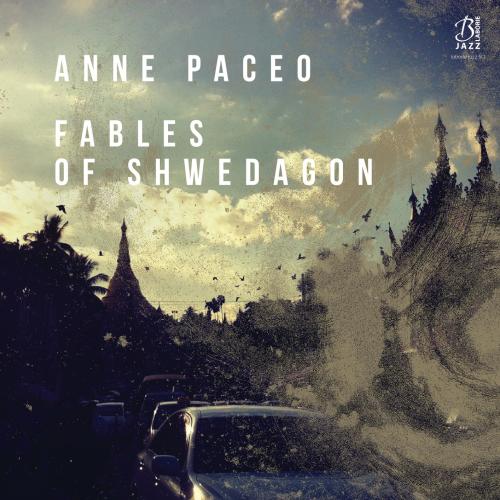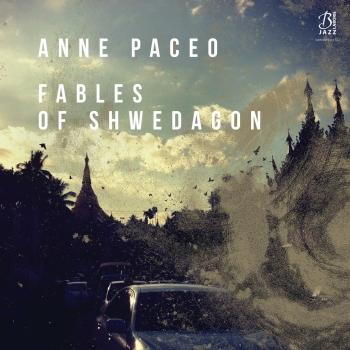
Fables of Shwedagon (Recorded Live on May 27th, 2017 at Festival Jazz Sous Les Pommiers, Coutances) Anne Paceo
Album Info
Album Veröffentlichung:
2018
HRA-Veröffentlichung:
26.04.2018
Das Album enthält Albumcover
- 1 Yin Padey Thar 08:45
- 2 Every Night Has a Morning 06:18
- 3 Le Soleil, la Lune, et l'Etoile du soir 06:36
- 4 Myanmar Folk Song 06:07
- 5 Hla Thuzar 06:02
- 6 Yamona 05:38
- 7 Fables of Shwedagon 05:27
Info zu Fables of Shwedagon (Recorded Live on May 27th, 2017 at Festival Jazz Sous Les Pommiers, Coutances)
"After nearly 60 years of dictatorship, Myanmar (formerly Burma) has been all messed up since the first democratic elections in 2010 and the lifting of the embargos. Until 2010, it was almost impossible for a Burmese to leave his country, and foreign influences were perceived as a danger by the military junta. For that reason, Burmese music and culture have not been much exposed to foreign influences. The result is a unique music, whose peculiarity has been preserved for decades.
The first traces of the traditional Burmese orchestra, called Hsaing Waing, date back to the seventeenth century and its composition has never changed to this day. Originally, the Hsaing Waing was played at the court of kings or during dance performances and puppet shows.
It is composed of 5 main instruments: the Hsaing Waing (21 tuned drums positioned in a circular style, played with hands), the Maung Hzaing (36 small gongs placed horizontally and vertically, played with bass drumsticks), the Chauk Lone Pat (2 big drums and 5 small ones, tuned and played with hands), the Hne (a kind of traditional oboe) and the Si Wa (small bell and wood block).The Hsaing Waing player conducts the group, he plays the main melody, gives the starts, changes the tempos and he is also the most respected musician in the group’s hierarchy. The Maung Zaing plays the ornamentations on the melody. The Hne plays the melodies and improvises. The Chauk Lone Pat plays the rythmics and gives the callings. The Si Wa marks the tempos.
Just like in jazz, there is a part of improvisation in Burmese traditional music. The musicians are able to play the same piece several times but each time in a different way. They are also able to improvise, which turns out to be the main bridge between the two cultures.
The main difference comes down to the notion of tempo; where jazz and contemporary musics try to keep a stable and permanent tempo, Burmese music is in constant motion, it speeds up and slows down, sometimes suddenly according to the intentions.
This group creates a real bridge between Burmese traditional music and French/European music, shaping a common ground and a new meeting space between 10 musicians from various horizons, thus creating a hybrid music, both luminous and boundless."
Hein Tint, Hsaing Waing
Kyaw Soe, Maung Zaing
Htun Oo, Hne, Flute
Kyie Myint, Chauk Lone Pat
Ye Minh Thu, Si Wa
Christophe Panzani, saxophones
Pierre Perchaud, guitar
Leonardo Montana, piano
Joan Eche-Puig, double bass
Anne Paceo, drums
Anne Paceo - Drummer
Anne Paceo lived an exceptional year crowned by the release of her second trio album 'Empreintes' on the Laborie/Naive label.
Her two trio albums with her band «triphase» have received particularly good reviews and the has band toured in many countries and festivals including Chile, Canada, Germany, France, Belgium, Switzerland, Algeria, Portugal, Taiwan, ..
Anne Is also leading a carrier as a «sidewoman» since her 19 years old. She has played with the cream of international jazz... China Moses, Rhoda Scott, Rick Margitza, Houston Person, Andy Sheppard, Christian Escoudé, Dan Tepfer....
The 27 year-old drummer received the award «Victoire du Jazz, révélation instrumentale 2011», «Django d’Or 2009» category “young talent”, and was selected for being the drummer of the European Jazz Orchestra 2010.
in 2006 and 2007 she had a monthly carte blanche at the prestigious Paris jazz club, 'le Duc des Lombards'. She has invited the cream of French and international jazz scene including Henri Texier, Rhoda Scott, Julien Lourau and Rick Margitza.
In 2007 she won the 1st prize as soloist at 'Sunside new talent Trophees'.
She also won the 'Young talent prize' at the Montauban festival, the '1st group prize' in the elimination contest “L’esprit jazz” and she has been chosen to play in New York with the CNSMDP for the close of the annual IAJE conference in the set preceding Charlie Haden’s Liberation Music Orchestra.
Anne Paceo started playing the drums when she was 9. Born in 1984, she took her first steps in jazz at the age of 12 at the Children for Jazz festival at Barcelonnette where she took part in the master classes of Dianne Reeves, Kenny Garrett and Ravi Coltrane.
In 2000 she studied under the direction of Sunny Murray for 1 years and then studied with Andrea Michelutti.
In 2004 she met the guitarist Christian Escoudé who invited her to join his Progressive sextet together with Marcel Azzola, Jean-Marc Jaffet, Jean-Baptiste Laya and Stéphane Guillaume. Subsequently she joined his trio and his quartet together with Geraldine Laurent and Florent Gac.
In 2005 she entered the Conservatoire National Supérieur de Musique de Paris and studied there with Dre Pallemaerts, Glenn Ferris, Hervé Sellin, Riccardo Del Fra, François Théberge and finished it with 'mention très bien'.
In 2006 she met the organist Rhoda Scott, known as “the bare-foot lady”, and they have played together in different musical projects since.
During 2007 she was regularly invited by Alain Jean-Marie to play in his quartet together with Guillaume Naturel and Darryl Hall.
She was also granted her 1st annual residence at the Duc des Lombards where she invited Pierre De Bethmann, Rick Margitza, Gilles Naturel, Emile Parisien and Yaron Herman. Her concerts have been broadcast by France Musiques in Claude Carriere and Jean Delmas’ program 'The Jazz Club'.
Over the past years we have been able to hear Anne play in the company of Rick Margitza, Rhoda Scott, China Moses, Andy Sheppard, Yaron Herman, Christian Escoudé, Joe Martin, Darryl Hall, Giovanni Mirabassi, Riccardo Del Fra, Laurent Dehors, Marcel Azzola, Stéphane Guillaume, Nelson Veras, Mederic Collignon, Sylvain Beuf, Henri Texier, Stéphane Kérécki, Alain Jean-Marie, Thomas Savy, Geraldine Laurent, Andy Emier, David Reinhardt, Eric Le Lann...
Dieses Album enthält kein Booklet













